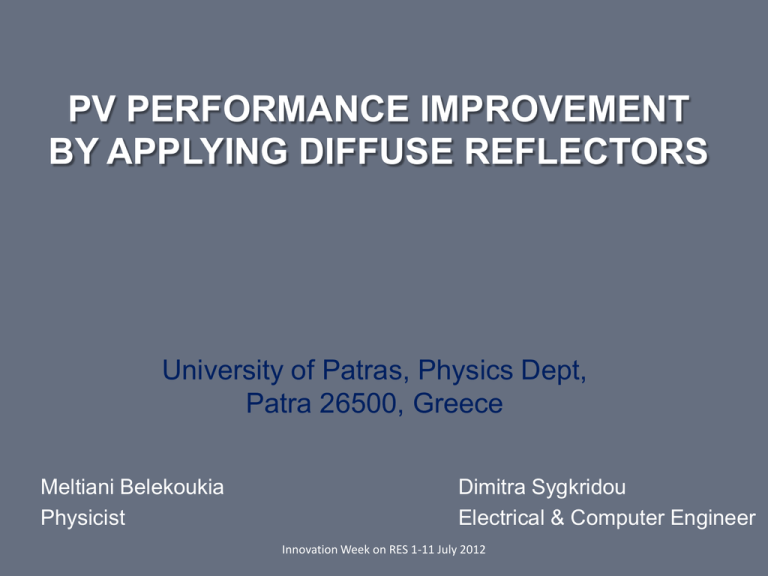pv performance improvement by applying diffuse reflectors
advertisement

PV PERFORMANCE IMPROVEMENT BY APPLYING DIFFUSE REFLECTORS University of Patras, Physics Dept, Patra 26500, Greece Meltiani Belekoukia Physicist Dimitra Sygkridou Electrical & Computer Engineer Innovation Week on RES 1-11 July 2012 Introduction PV modules can be installed on the façade or roofs (horizontal or inclined) in order to cover 1). Electricity demands for lighting and operation of devices 2). Space heating and cooling needs Reflectors can be combined with the PV modules in order to meet the residential and industrial building energy demands. Booster diffuse reflectors • Diffuse reflectors have been suggested to provide more solar radiation especially from spring to autumn. Direction of the reflected solar rays on the PV surface Installation of diffuse reflectors on building roof In stationary installation, PV modules are placed in parallel rows with a distance between them. Booster reflectors can be placed between the parallel PV rows smoother distribution of the additional solar radiation cost effective performance improvement Experimental study • a-Si PV modules from uni-solar (model LM-1212) with a steady slope angle of 40 degrees were used, oriented to the sun The first PV panel (images on top) was tested with a booster diffuse reflector and the second one (image on the bottom) was used as a reference Circuit layout and instruments Our circuit layout consisted of a variable resistance, a small resistance of 0.47 Ω in series and two digital multi-meters one for the PV voltage and the other one for the current • • • Pyranometer Theodor Friedrichs & Co Two digital multi-meters One thermometer I-V curve for diffuse aluminum, white reflector and reference • An increase of incident solar radiation causes a rise of the Isc • An increase of incident solar radiation causes a rise of the PV temperature that causes a decrease of the Voc Better results with the diffuse aluminum reflector Experimental results • Better results when using booster diffuse reflector from aluminum sheet than white reflector • when using the aluminum diffuse reflector the radiation increased up to 35% which led to 27% maximum power output gain while the PV temperature increased only by 5.5 degrees C • when using the white diffuse reflector the radiation increased up to 17% which led to 7% maximum power output gain while the PV temperature increased only by 4 degrees C Intensity of solar radiation for different types of reflectors • Comparing the two different types of diffuse reflectors greater intensity of solar radiation can be achieved with the aluminum reflector • Specular reflectors are not suitable for use with PV modules because the variation of the reflected solar radiation results to a non-uniform density of illumination on the PV surface. If we used a specular reflector, parts (or cells) from the PV surface would have a higher illumination and other parts (or cells) a smaller one. Conclusions • The use of booster diffuse reflectors in front of a photovoltaic module is a suggested technique for increasing the radiation onto the module • Reflectors increase the cost of PV installation, but the increase of the maximum power output can overcome this additional cost Reflectors are cost effective. • Diffuse reflectors achieve smoother distribution of the additional solar radiation THANK YOU FOR YOUR ATTENTION D. Sygkridou dsigridou@upatras.gr M. Belekoukia meltiani_bel@yahoo.com Innovation Week on RES 1-11 July 2012




